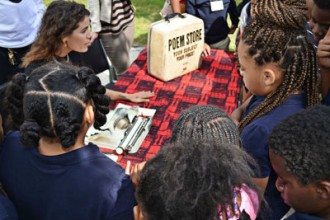 Last week’s release of US Census Bureau data about school finances lead to giant-font headlines all over the state about the spending of the Milwaukee Public Schools.
Last week’s release of US Census Bureau data about school finances lead to giant-font headlines all over the state about the spending of the Milwaukee Public Schools.
The Census Bureau took a look at the fifty largest school systems in the country and ranked them by per-pupil total spending (in the 2009-2010 school year), and MPS landed at fourth. Meaning, of all the large districts in the country, only three – New York City, Washington DC, and Baltimore – spent more per student than Milwaukee did.
This raised hackles across the internet; apparently, lowly Milwaukee isn’t allowed to spend so much! Or perhaps more legitimately, lowly Milwaukee should be expecting better returns on its investment – as national test data show, MPS is not ranked fourth in achievement.
MPS reacted by pointing out, rightly, that just because MPS ranks high in spending compared to its peers, it is not ranked that high in Wisconsin. MPS is 27th in spending for the state – a fact omitted from the Milwaukee Journal Sentinel story about the new numbers (though other outlets included it in their reports). Now, to be fair, most of those 26 other districts are very rural, up by Canada and the UP, and the top “district” in Wisconsin, which MPS notes almost with incredulity spends $32,000 peers student (vs. MPS’s $14,000) is the Norris Adolescent Center.
Still, it should be worth noting that MPS isn’t even tops in Milwaukee County; that honor belongs to the Nicolet High School district ($17,000 per student), followed closely by the overlapping Maple Dale-Indian Hill district ($15,000 per student). Heck, Nicolet collects more in property taxes per student ($14,300) than MPS spends in total per student.
Perhaps the worst response to the news was from the right-wing MacIver Institute, which lost no time trashing Milwaukee and its teachers, and even bending the truth: “Wisconsinites had long known that Milwaukee’s public schools had some of the highest per-pupil spending in the state, but few would have predicted that it was one of the highest in the country,” they write.
Not only is MPS not the highest in Wisconsin, it barely cracks the top 20% nationally. The Census Bureau gave per-pupil spending totals for 13,515 districts in 50 states and DC, and Milwaukee ranked way down at 2607th, hardly “one of the highest in the country.”
But in stories like this, I like to talk about what I call the resource gap: Even though per-student spending is high in Milwaukee’s public schools, it still can’t compete with the resources available in areas that are not so poverty-stricken.
MPS reports that more than four out of every five of its students qualify for free or reduced lunch, the universal benchmark for poverty. (Nicolet, by comparison, claims just 10%.) A typical household in the City of Milwaukee has an annual income of about $33,000. In some areas of the city, it’s considerably less – the 53233 ZIP code in the middle of the city has a median household income of just $13,000.
By comparison, Glendale, the suburb home to Nicolet, has a median household income is nearly twice Milwaukee’s, at $60,000. Fox Point, home to Maple Dale-Indian Hill, has a median household income offer $96,000.
If you imagine students’ lifetimes, the first 18 years or so when they’re getting their primary and secondary education, the gap in resources available to them is pretty dramatic between inner-city Milwaukee and its suburban neighbors. I am not suggesting some giant-reallocation scheme, but consider that, say, a $45,000 annual difference in resources available for a family to spend on its children is pretty severe compounded over those 18 years – nearly a million dollars.
Higher school spending is one way we try to close that resource gap.
Of course, Nicolet and Maple Dale-Indian Hill far outpace MPS’s per-student spending, so those aren’t necessarily good examples. But you can look at other Milwaukee County suburbs – Shorewood, Whitefish Bay, Oak Creek-Franklin, West Allis-West Milwaukee, and so on – and even though MPS outspends them by between $2,000-$4,000 a year, those cities all have higher annual median incomes by between $10,000 and $70,000. The resource gap is there.
Indeed, much of the money MPS has that allows it to spend beyond its neighbors comes from the federal government in the form of Title I funds, which is specifically designed to help high-poverty districts bridge that gap.
And, let’s be frank. The reason the Norris Center is the highest-spending district in the state is because its kids have tremendous gaps to overcome – in their case, mental health or substance abuse or other special needs. No one (I hope) would deny them the funding to close that gap.
Why then would there be such an outcry against MPS, for its spending to bridge the resource gap?
I am not suggesting that money solves all problems or advocating some massive redistributionist scheme. Rather, I am just asking for an understanding that MPS’s spending is not just not the highest in Wisconsin, it also is not without cause or need. If we can close the resource gap in some other way, then I’m all for it – and MPS can start spending less.

